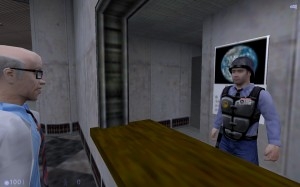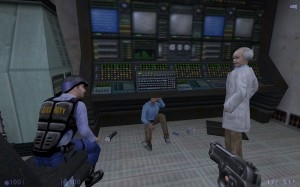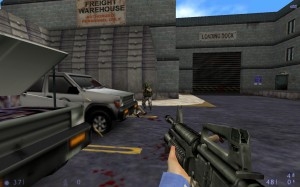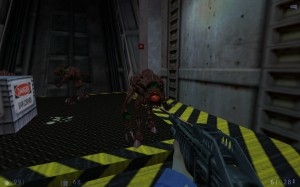Written by: The J Man
Date posted: June 17, 2008
I liked Half-Life. Hell, I don’t know anyone who didn’t like Half-Life. I liked its first expansion, Opposing Force. It was a neat twist, and while you never actually played the bad guy per se, it did offer the series a closure that first game lacked (read: KA-BOOM!). However, it also unwittingly set a devious precedent: the story of the downfall of Black Mesa could go on forever, so long as you retold it from a different angle each time. This worked for Opposing Force. For Blue Shift and Decay (the exclusive added value for the PS2 port), the idea wears pretty thin. The star characters are literally on the fringe of Half-Life‘s core narrative, which results in uninspired side stories about uninteresting people.
The uninteresting person here is one Barney Calhoun: security guard extraordinaire, and Gordon Freeman’s BFF in Half-Life 2. Now, at the risk of a few minor spoilers, I will first admit that when the bug bit me to replay Blue Shift, I remembered it having more bearing on the continued Half-Life story than it actually does. For some reason, I had the impression that key characters from HL2 had escaped from Black Mesa with Barney, and those events were chronicled in Blue Shift. That’s barely correct. Barney escapes (obviously). He escapes with some named scientists. You’ll never see those scientists again.
The stories could have easily been tied together, but Valve didn’t share any sequel notes they may have had with Gearbox, and they pretty obviously didn’t give a rip about the events in Blue Shift. To Gearbox’s credit, this game does fit seamlessly into the first Half-Life, giving Barney Calhoun a clear place in that timeline. But as far as being a story that needs to be told? Nuh-uh. He exists in the timeline, but he doesn’t do anything of significance. Barney Calhoun here barely meets Gordon in the course of the game, his actions have no impact on the events at Black Mesa, and his adventures here don’t play into HL2 whatsoever. Originally, “Barney” was just the name for all the guards in HL1, as in “Barney Fife” from Mayberry. It’s why they all looked the same, and going back to say that all along this Barney is the one that helped Gordon out (which he never actually does in Blue Shift) is completely pulling a George Lucas.
 I start with laying all this out because the promise of expanding upon the Half-Life storyline is the major reason to play Blue Shift. If it’s 2001, and you’re waiting for Half-Life 2, Blue Shift would be appealing because of the implicit promise to round out the first game with backstory that will be referenced in the sequel. If it’s 2006, and you just played Half-Life 2, Blue Shift would be appealing because of the implicit promise to explain Barney Calhoun. It fails to do either. You do get a slightly extended explanation of the “resonance cascade” and the importance of the border world, as well as a look at some of the early equipment testing both (not as interesting as it sounds), but nothing that’s critical information or a startling revelation. The important parts were already covered in Half-Life; what tries to pass as expounded detail here is just babbling pseudo-science.
I start with laying all this out because the promise of expanding upon the Half-Life storyline is the major reason to play Blue Shift. If it’s 2001, and you’re waiting for Half-Life 2, Blue Shift would be appealing because of the implicit promise to round out the first game with backstory that will be referenced in the sequel. If it’s 2006, and you just played Half-Life 2, Blue Shift would be appealing because of the implicit promise to explain Barney Calhoun. It fails to do either. You do get a slightly extended explanation of the “resonance cascade” and the importance of the border world, as well as a look at some of the early equipment testing both (not as interesting as it sounds), but nothing that’s critical information or a startling revelation. The important parts were already covered in Half-Life; what tries to pass as expounded detail here is just babbling pseudo-science.
So there’s the first caveat – instead of a companion piece, the events in Blue Shift happen off on their own, and Barney Calhoun is the guy from this game only because it doesn’t matter. Overlaps with the original do occur, but rarely, and never on the level you’d hope for, or expect. I can understand why you wouldn’t want to play directly as one of the throwaway guards from the first game (complete with a lanky Gordon Freeman model you have to lead around and open a gate for, or somesuch) but I would think at the very least there could be a scripted event or two from Half-Life that you could trigger or have explained by Barney’s actions in Blue Shift. Nothing this clever ever happens.
Now that I’ve just kneecapped any interest you might have had, let’s at least look at what Blue Shift does right.
As said, you’re a mid-level security guard for Black Mesa, and you’re just starting your shift on THAT DAY. The introductory sequence mirrors the one in the first game, as you take the train to the guard station, grab your equipment, and head out to rescue some scientists who can’t figure out how to press the elevator’s “down” button. There are no enemies yet, just foreshadowing and scene-setting. You’ll note that more than a few systems are on the fritz today. You’ll spot Gordon heading to suit up. You’ll see Dr. Cross (or Dr. Green, I get them confused) on a security monitor, shuttling THE CRYSTAL. Everyone, everyone, will make a loaded comment about how you’d better prepare for “a long day.” The suspense here is actually fairly delicious. The entire time you’ll know that catastrophe awaits, with no clues as to precisely when. You’ll be perched on the edge of your seat waiting for IT to happen. I kept looking around the walls, trying to guess what would explode at any minute, as a little movie of Gordon inching closer to disaster played in my head.
 When things finally fall apart, you’ll probably feel a little underwhelmed. Aside from a very brief glimpse of chaos as the event unfolds (unique to this title) you’ll take a concussion nap and wake up after things have mostly settled in. Aliens have entirely overrun the facility. The military is already in position. Gordon is nowhere to be found. This has the effect of dropping you right into the action, and sets up the game’s policy of breezing through itself as quickly as possible. This is a short game, and with all the pieces already in play, you’re ready to cruise through the alien section, the military section, the Xen section, and the gizmo section in five hours or less.
When things finally fall apart, you’ll probably feel a little underwhelmed. Aside from a very brief glimpse of chaos as the event unfolds (unique to this title) you’ll take a concussion nap and wake up after things have mostly settled in. Aliens have entirely overrun the facility. The military is already in position. Gordon is nowhere to be found. This has the effect of dropping you right into the action, and sets up the game’s policy of breezing through itself as quickly as possible. This is a short game, and with all the pieces already in play, you’re ready to cruise through the alien section, the military section, the Xen section, and the gizmo section in five hours or less.
Now, Half-Life, in my eyes, was more of an adventure. It did shooting well, it did suspense well, but it was at its best when you were stuck in precarious, rushed, life-or-death situations. Whether it was inching along a broken catwalk over a bottomless pit, or being stuck in a pipe with a satchel charge thrown in your face, these kind of Die Hard moments made the game for me. They’re strangely absent from this title. Instead, Blue Shift focuses on the combat, which, while handled well, fails to make it anything special. You’ll be facing the same run-and-gun battles as any other FPS, with the familiar Half-Life locales of sewers, offices, warehouses, train yards, and mechanical basements used as mere backdrops.
The most detailed sections simply act as arenas for large-scale battles – a couple of places in the train yard come immediately to mind, culminating in hosing down a stream of military grunts with a mounted machine gun. It’s hard to classify as “boring,” but without the vertigo-inducing environment sections, or the weight of Half-Life‘s story, it comes off like any of the good shoot-em-up fan maps you can download off the Net. For free, I might add.
 I will give Blue Shift credit for being uniquely challenging at the hardest difficulty level. A couple of factors play into this. While Barney has the same capabilities as his predecessors, he lacks powered armor. This limits him to a traditional Doom-style hunt for armored vests to refill that meter, which are much more limited than the HEV rechargers from Half-Life. Health stations are limited as well. I remember passing up to three during key battles in the original, each just a few rooms from the last. Here, you’ll be lucky to find one per level. Ammo is also noticeably limited, to the point that I got myself into an inescapable situation (4 health, no bullets, and 5 alien warriors ahead) and was forced to restart. Lesser difficulty levels are perfectly playable though, as weaker enemies mean carefully selecting your shots isn’t as necessary.
I will give Blue Shift credit for being uniquely challenging at the hardest difficulty level. A couple of factors play into this. While Barney has the same capabilities as his predecessors, he lacks powered armor. This limits him to a traditional Doom-style hunt for armored vests to refill that meter, which are much more limited than the HEV rechargers from Half-Life. Health stations are limited as well. I remember passing up to three during key battles in the original, each just a few rooms from the last. Here, you’ll be lucky to find one per level. Ammo is also noticeably limited, to the point that I got myself into an inescapable situation (4 health, no bullets, and 5 alien warriors ahead) and was forced to restart. Lesser difficulty levels are perfectly playable though, as weaker enemies mean carefully selecting your shots isn’t as necessary.
Opposing Force introduced AI squadmates with defined roles, new weapons, new textures, new mechanics (like radio strikes), and new enemies. Not only does Blue Shift NOT include anything like that, it strips away what advancements were made. You’re back to a game built by shuffling around the pieces of Half-Life’s original toolset. Many rooms look like they could have been lifted from maps in the first, as nothing new was done with them, resulting in a general feeling that you’ve played through these areas before. Now don’t get me wrong, limited retexturing is done. Your sleeves are blue now, and you’re not wearing an HEV suit. You’ll play the same hazard course, but with a holographic security guard instead. You’ll meet a brand new character named Dr. Rosenberg, with a brand new face and voice to match. But that’s the entire list of core changes.
Some have said that Blue Shift, clocking in at the five-hour range, is too short. Since nothing of consequence happens, and there’s nothing new to play with, I would argue it’s a perfect length. You get a sample of all the major points from HL1, a few new areas, and you’re out before you really have time to complain. You won’t even face a boss, or any complicated mechanical puzzles, just shooting interspersed with occasional bits of dialogue. Despite being a security guard, and tasked with the safety of personnel, interaction with scientists is limited to leading just one around in a short segment, and opening the doors for a truly absurd number of scientists trapped in railcars. I can’t imagine mistakenly locking yourself in a freight car happens as frequently as it does in this game, but prepare yourself for a lot of “No! I’m not Dr. Rosenberg! Try the next train!” Additionally, the ones that have the misfortune of not being Dr. Rosenberg simply get left behind (as there’s nowhere to lead them). Ice cold, Barney. Ice cold.
The CD release contains a “High Definition Pack” meant to smooth the edges of what would have been a four-year-old engine by that time. Textures and the environment don’t benefit noticeably, but character and weapon models get upgraded with a higher poly count. It makes a striking difference for the characters, rounding out jaggies, adding details like flowing ties and ID tags on uniforms, and cleaning faces into something a little more human. Barn… well I can’t call them “Barneys” anymore, now can I? – the security guards who aren’t you look much better, as do the helmets, goggles, and limbs of the soldiers. The scientists don’t benefit quite as much, and the old guy with the moustache looks oddly squished. The weapons are less impressive – more realistic than the originals, certainly, but beaten solidly by the models from Counter-Strike. They do get upgraded effects though, which all sound much better. The thunderous chatter of the MP5-turned-M16 is a particular highlight. The pack is impressive enough to install as an “eh, why not?” upgrade, but far from necessary. The Steam version omits this pack with its standard release, but you can download it as an update to all the original Half-Life games.
 Blue Shift was originally meant to be the added value for the cancelled Dreamcast port of Half-Life. Under that judgment, it’s perfect. It reuses assets, fits into the story neatly, offers more of the same, and doesn’t overstay its welcome. As a standalone expansion, harumpfh. Strike one is failing to match up to OpFor in terms of quality and additions. Strike two is coming out four years after the original and simply rehashing pieces from it, with an arguably useless storyline. Strike three is failing to match up to the quality of many free mods released from homebrewers in their spare time. When you look at mods like They Hunger and Poke646, it’s hard to justify actually asking money for Blue Shift.
Blue Shift was originally meant to be the added value for the cancelled Dreamcast port of Half-Life. Under that judgment, it’s perfect. It reuses assets, fits into the story neatly, offers more of the same, and doesn’t overstay its welcome. As a standalone expansion, harumpfh. Strike one is failing to match up to OpFor in terms of quality and additions. Strike two is coming out four years after the original and simply rehashing pieces from it, with an arguably useless storyline. Strike three is failing to match up to the quality of many free mods released from homebrewers in their spare time. When you look at mods like They Hunger and Poke646, it’s hard to justify actually asking money for Blue Shift.
It’s a nice length, some action happens, and limited ammo (plus the inability to recharge your armor) makes this one a slightly different challenge for Half-Life vets. If you want to play a small bit of Half-Life again, without actually playing Half-Life again, Blue Shift might be worth consideration. Just remember that the storyline here is as much of a throwaway as the guard characters it’s based off of, and none of the magic that made Half-Life a true experience is included. The Dreamcast asking price (a free addition) is exactly what it’s worth.


 Posts
Posts